Appropriate nitrate levels for different corals.
Printed From: Utah Reefs
Category: Specialized Discussion
Forum Name: Reef Chemistry
Forum Description: A place to discuss reef chemistry.
URL: http://www.utahreefs.com/forum/forum_posts.asp?TID=41866
Printed Date: August 27 2025 at 5:07pm
Software Version: Web Wiz Forums 12.03 - http://www.webwizforums.com
Topic: Appropriate nitrate levels for different corals.
Posted By: fishoutawater
Subject: Appropriate nitrate levels for different corals.
Date Posted: June 23 2010 at 10:35pm
|
I know some are not bothered by them as much as others, softies, most of the lps. But what is the highest level tolerated by sps like montis, acros, birdnests, millie's. And do hydnophora do better with very low nitrates? My tank has never tested below 20, and sometimes as high as 50, I am guessing this is the reason why not all of my pieces are thriving. ------------- Some day, when I grow up,... |
Replies:
Posted By: BobC63
Date Posted: June 23 2010 at 10:40pm
|
I think you may be correct. SPS in general are less tolerant of nO3 than more hardy corals.
What are you doing in terms of trying to bring the nitrate levels down?
Things that could help reduce nO3 include:
- Adding a protein skimmer (if you don't have one) or getting a bigger / better one (if you do)
- Adding a refugium (again if you don't have one)
- Adding more Live Rock into your system
- More frequent partial water changes
- reducing feeding amounts / frequency
------------- - My Current Tank: 65g Starfire (sitting empty for 2+ years) - * Marine & Reef tanks since 1977 * |
Posted By: fishoutawater
Date Posted: June 23 2010 at 10:44pm
|
My skimmer is working great, I do have a fuge with live rock rubble and caulerpa on a reverse lighting schedule. I started running a filter sock about 4 months ago, sock used to clog in three days, now it takes about 5-6. I feed a pinch of pellets sometimes once a day, sometimes less. Every few days I break off a piece of Curtis' frozen concoction. I probably have about 50 gal in my system, and typically do a couple of 5 gal changes per month. I am debating adding a rdsb to see if that remedies the nitrates. There is about 50 lbs of live rock, and 6 small fish(under 3") in the system. ------------- Some day, when I grow up,... |
Posted By: BobC63
Date Posted: June 23 2010 at 10:46pm
|
A rdsb is a good idea.
Sounds like everything else is about where it should be.
What kind of skimmer do you have?
How many lbs of LR in your display? ------------- - My Current Tank: 65g Starfire (sitting empty for 2+ years) - * Marine & Reef tanks since 1977 * |
Posted By: Shayne
Date Posted: June 23 2010 at 10:51pm
|
What is a rdsb?
------------- 21G Reefer Nano |
Posted By: BobC63
Date Posted: June 23 2010 at 10:55pm
|
Remote Deep Sand Bed
most common way is using a 5g bucket filled with sand and plumbed to the sump. ------------- - My Current Tank: 65g Starfire (sitting empty for 2+ years) - * Marine & Reef tanks since 1977 * |
Posted By: fishoutawater
Date Posted: June 23 2010 at 10:57pm
skimmer is one of a kind, it is outperforming my old tricked out ASM G1x
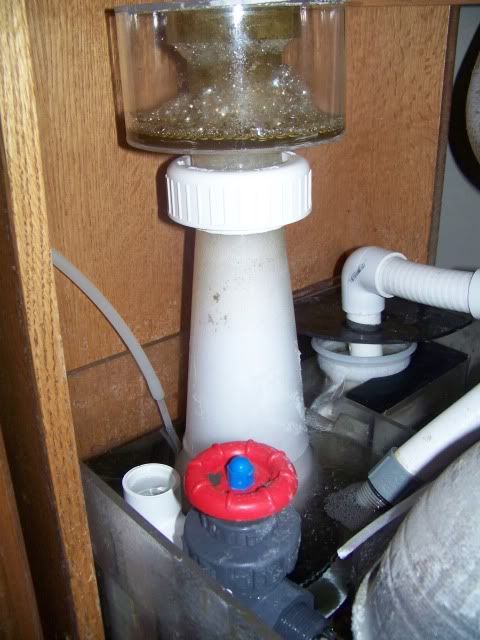 About 50 lbs of live rock.
Here are some other pics to give you a better idea.
 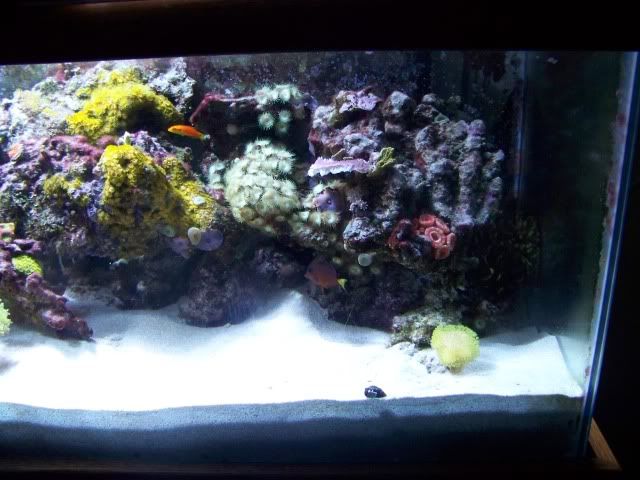 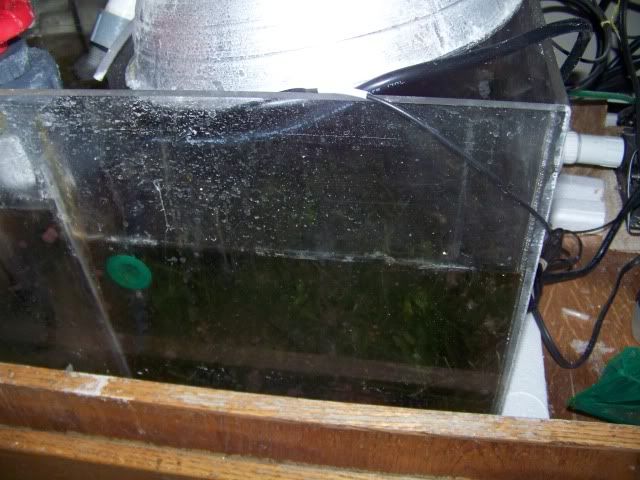 ------------- Some day, when I grow up,... |
Posted By: BobC63
Date Posted: June 23 2010 at 11:14pm
|
Looks good to me! I only saw 1 fish in your pictures.
How many fish do you have in there? ------------- - My Current Tank: 65g Starfire (sitting empty for 2+ years) - * Marine & Reef tanks since 1977 * |
Posted By: fishoutawater
Date Posted: June 23 2010 at 11:17pm
|
I can see 3, but I know where to look. There are 6 total.
two spot hogfish
2 gsm clowns
yellow watchman/pistol shrimp
blue eyed tang
target mandarin ------------- Some day, when I grow up,... |
Posted By: BobC63
Date Posted: June 23 2010 at 11:31pm
|
Hmmm...
I would say try out the rdsb; and if you don't see enough of an improvement, then try changing out 10g of water at a time instead of the 5g you do now...
Other than that I can't think of anything else. ------------- - My Current Tank: 65g Starfire (sitting empty for 2+ years) - * Marine & Reef tanks since 1977 * |
Posted By: SGH360
Date Posted: June 24 2010 at 12:00am
|
Here is a website that help me understand alot about what are tolerable nitrates and whatnot
http://joejaworski.wordpress.com/2007/11/12/nitrates/ - http://joejaworski.wordpress.com/2007/11/12/nitrates/
|
Posted By: fishoutawater
Date Posted: June 24 2010 at 12:18am
|
Thanks for the link, I may have to look more into the coil denitrator, space is at a premium, I might have issues with my Sweetie if I add any more "clutter" to the office. ------------- Some day, when I grow up,... |
Posted By: Mark Peterson
Date Posted: June 24 2010 at 9:15am
|
There are several things that can be done without having to add more "stuff". The tank looks very nice. I see lot's of good growth, fuzzy, well hydrated LPS and what is that yellow? Yellow Polyps? Larger growth of things like Yellow Polyps and GSP actually inhibit other coral growth. Are you using AC? I would do an easy experiment to try and isolate the cause of the Nitrates. I would stop feeding for 4-5 days and then check Nitrates. If the levels have not gone below 20 then I'd next leave the Regugium lights on 24 hrs/day and see what effect that has. How rapid and how thick is the growth of algae in the Refugium? It should double about every 4-6 weeks requiring regular harvesting. Is the sand bed relatively undisturbed? It looks a little too white in the pic. What I mean is that there are so many things that live in the sand that process waste. Okay, one last question.  I know I ask a lot of questions. Is there a DSB in the Refugium? LR rubble is less useful than a DSB for filtration. I know I ask a lot of questions. Is there a DSB in the Refugium? LR rubble is less useful than a DSB for filtration.------------- Reefkeeping Tips, & quick, easy setup tricks: www.utahreefs.com/forum/forum_posts.asp?TID=9244 Pay it forward - become a paid WMAS member 
|
Posted By: Jake Pehrson
Date Posted: June 24 2010 at 10:04am
|
I think the above recommendation are pretty good. -I am not sure if you mentioned the sand depth in you refugium. I would just add more sand. The smaller the grain size the less you will need. -Do large water changes until your nitrates are below 20 -DIY foods like "Curtis' frozen concoction" are great, but the problem is that it will add a lot of nutrients to the water that will not be consumed easily. Get a strainer or some cheese cloth and rinse the food before adding it to your aquarium. -up your skimming if possible -run carbon ------------- Jake Pehrson Murray http://coralplanet.com" rel="nofollow - coralplanet.com http://utahbeeranch.com" rel="nofollow - :) |
Posted By: Adam Blundell
Date Posted: June 24 2010 at 10:14am
|
I didn't read above so it may have been said...
Strive for zero, but I have seen many beautiful systems at fifty ppm. Adam ------------- Come to a meeting, they�re fun! |
Posted By: fishoutawater
Date Posted: June 24 2010 at 11:37am
|
I usually blow out the perimeter of the sand with a turkey baster every few days, sand bed depth in the display is around 4", it is very fine, probably one grade up from oolitic. No sand in the sump, just live rock rubble and caulerpa. I do run carbon in the return chamber of the sump. The gsp shows no visible growth since I have had the tank, I think I'm the only person in the valley that can't grow gsp! ------------- Some day, when I grow up,... |
Posted By: Matthew
Date Posted: June 25 2010 at 4:11pm
|
edited for an addition once I read the article linked http://joejaworski.wordpress.com/2007/11/12/nitrates/ - http://joejaworski.wordpress.com/2007/11/12/nitrates/
From the article:
"Fish that consume the food stop the decomposition to ammonia and break the cycle. In other words, fish excrement does not contain any nitrates. Fish will eliminate the nitrates for you, as long as everything you put in the tank gets eaten"
Not True! Utilization of protein (amino acids) = ammonia. Ammonia is excreted by fish. Hence freshwater fish tanks are cycled by a fish that you don't feed.
And now totally off the nitrate topic. :)
Hydnophora looks like an SPS but will do better if treated as LPS.
Matthew
|
Posted By: SGH360
Date Posted: June 25 2010 at 4:31pm
| What are you talking mattew? im kinda confused on what are you're trying to explain |
Posted By: bugzme
Date Posted: June 25 2010 at 4:35pm
|
I have no clue!!! either ------------- Jeff 125 tank 50 gallon sump T-5 lighting Rum drinker, Carbon User I KNOW ROCKS THAT ARE YOUNGER THEN ME!! I AM A Realist! I write what I think!! |
Posted By: jmorrell
Date Posted: June 25 2010 at 7:51pm
|
Posted By: jmw
Date Posted: June 25 2010 at 8:14pm
| could it be possibe that blowing the perimeter of the sand bed is stiring the nitrates in the sand bed? |
Posted By: Matthew
Date Posted: June 25 2010 at 10:40pm
|
Which part didn't people understand? :/
I guess no one has read all the posts???
He mentioned Hydno as SPS and was wondering how their parameters were different. In the very first post, they are not a typical SPS.
The article linked about halfway down page one contains some very erroneous information. I then relinked it and attempted to correct the info. The idea that fish DON'T excrete ammonia??????????? NOT TRUE
Or nevermind...
|
Posted By: SGH360
Date Posted: June 26 2010 at 1:04am
Oh i see when you just quoted a sentence of the paragraph it also caught me off guard and confused me
Here's the full paragraph
"The number one source of nitrates is feeding. Most nitrates come from the proteins in uneaten fish food that metabolizes into ammonia. Fish that consume the food stop the decomposition to ammonia and break the cycle. In other words, fish excrement does not contain any nitrates. Fish will eliminate the nitrates for you, as long as everything you put in the tank gets eaten. Fish feces will decompose to ammonia, but the levels are far less intense than an equivalent weight of uneaten frozen fish food breaking down in the water."
What the paragraph is saying that food itself is not comes with nitrate but if you let it decompose it will turn into ammonia then to nitrite and finally to complete the cycle nitrate. When fish eat the the food will not decompose and turn into ammonia, nitrite then to nitrate. Fish excrement are not nitrates but just as it decomposes it turn into ammonia then to nitrate. What hes saying if all of the thing that decompose gets eating you'll not have high nitrates. Thats why protein skimmers come into play to stop anythign that will decompose including fish excrement
|
Posted By: Mark Peterson
Date Posted: June 26 2010 at 8:49am
|
I say it like this, Fish pollute the water while Coral filter the water. Anything that removes the uneaten food or the resulting poop, like a floss bag or a skimmer will reduce the load on the biological filtration. But it is also ttrue that the greater the Biofiltration, the greater the capacity for handling extra waste. If set up adequately, Biofiltration can grow fairly quickly to handle an increase in waste. As Adam pointed out in a recent post, one of the major causes for high N compounds is inadequate Biofiltration. Does this make sense? ------------- Reefkeeping Tips, & quick, easy setup tricks: www.utahreefs.com/forum/forum_posts.asp?TID=9244 Pay it forward - become a paid WMAS member 
|
Posted By: downhill_biker
Date Posted: June 26 2010 at 9:06am
As far as the food goes...If you are battling nitrates or ammonia issues I would stop feeding my food all together until it is under control. I dont think that straining it is going to help that much and whatever it does remove will likely be what the corals eat. I would just feed something like frozen mysis or something for a while. No flake or pellet foods either, they wont help anything when it comes to nitrates. I agree with what has been said above, run carbon. If you can hook up a RDSB that would add a TON of biological filtration. You could also potentially look into a sulfer dinitrifier. I would call Eric at Marine Aquatics if you want to find out more about one of those or get one made. ------------- Make sure you post your best pictures every month in our POTM forum. |
Posted By: Matthew
Date Posted: June 26 2010 at 6:38pm
|
This is probably worth knowing.
Protein = amino acids
The amine in amino acids = nitrogen, as amino acids are utilized this becomes = ammonia
So protein utilization = ammonia
In humans this ammonia is converted into urea, then urinated out (we lose a little to sweat) this is called the Urea cyle (or ornithine cycle).
In fish this ammonia is not converted much, but instead excreted mainly by the gills, and also in urine. (couldn't really call it the Urea cycle so the ornithine cycle)
So the fish food eaten by fish and all the rest of your invertebrates becomes ammonia, so more fish = more ammonia (even if you protein skim their poop out)
Anything that is photosynthetic ties up nitrogen, so macro and micro algae, sea grass, mangroves, zooxanthellae in corals. In photosynthetic corals the zooxanthellae take up all the ammonia that coral produce and then more.
The amino acids in decaying fish food don't become ammonia until detrivores, bacteria ect converts it into ammonia.
This is where a protein skimmer to remove excess food, decaying algae, ect is effective, but this is also why you need some other method of nitrate removal.
|
Posted By: Mark Peterson
Date Posted: June 27 2010 at 9:03am
Well said, Matthew. This thread has advanced to more than what fishoutawater was originally asking. I wonder if this was a question posed not so much for his enlightenment but more for general discussion?
I've found that even tanks with near zero Nitrates cannot grow some things that other tanks can. The reason why seems to simply be the differences in the way the tanks are set up filtration-wise and the tankmates. Some coral get along with their neighbors and others don't. Since GSP don't do well, have you tried green Briarium? It has a similar look with green polyps covering surfaces. ------------- Reefkeeping Tips, & quick, easy setup tricks: www.utahreefs.com/forum/forum_posts.asp?TID=9244 Pay it forward - become a paid WMAS member 
|
Posted By: fishoutawater
Date Posted: June 27 2010 at 3:59pm
|
Fwiw, I am aware that hydnophora are not sps, I reread it and don't see anywhere that I said they were. I listed it specifically because it is one of the few lps that has not done well in my tank, as of yet.
The gsp came with the setup when I bought it 2+ years ago, in that time it has never spread. In fact it had lost almost all of its color and is just now greening up again.
Thanks for all the helpful posts, I started this thread because I was trying to figure out if the next step in improving my tank was the reduction of nitrates, or if there was another likely culprit of uninspiring coral growth, especially in the few sps colonies that I do have. I have not had much experience with the more demanding corals yet and so was looking for a little input, hopefully this helps a few more hobbyists as well. That said, let's play nice?
I have drastically reduced the amount of food put in the tank since starting this thread, I will check nitrates shortly and see if it has made a measurable difference yet. Any guesses on how soon I should be able to measure a difference? After just a few days, both anemones are looking happier, good indicator, or just coincidence?
I have about a dozen nassarius snails as well as a pistol shrimp who never, never stops moving sand, I don't think blowing out a little more would hurt. I have never come across any black/grey areas in the sandbed, or had any funky smells come out of it. Is this a bad thing to do?
One more question, what are some of the more hardy sps corals? I have a few monti plates that are starting to come around and show good growth, color and extension. I would guess that they are one of the easier ones? ------------- Some day, when I grow up,... |
Posted By: jwoo
Date Posted: June 27 2010 at 5:05pm
|
Monti plates are easy. Digitata is really easy - I started with that before getting into other demanding SPS. Benefit is they grow REALLY fast. Milli's have always been easier for me but your mileage may vary. ------------- None at the moment Soon: 72 Gallon Bowfront |
Posted By: Matthew
Date Posted: June 27 2010 at 6:10pm
|
Absolutely sorry for saying that you thought hydnophora are SPS.
Though I won't say they aren't SPS, because you very easily could classify them as SPS depending on what your criteria is
+1 to Monti digitata and Monti cap being generally easy SPS to grow. Though I have a friend that has a hard time keeping Monti's alive and does well with Acro's
Movement in the sadbed is not bad generally (depending on what you are trying to achieve), but will stop the denitrification ability of that sandbed.
Sandbeds need areas that are less disturbed to become anaerobic (without oxygen) in order to denitrify. To much of being undisturbed will result in anoxic areas that can then be an issue creating toxic compounds. For this reason many with remote deep sandbeds will replace the whole setup on a regular basis.
|
Posted By: fishoutawater
Date Posted: June 27 2010 at 6:31pm
If the sandbed is producing bubbles, isn't that a sign of denitrification?
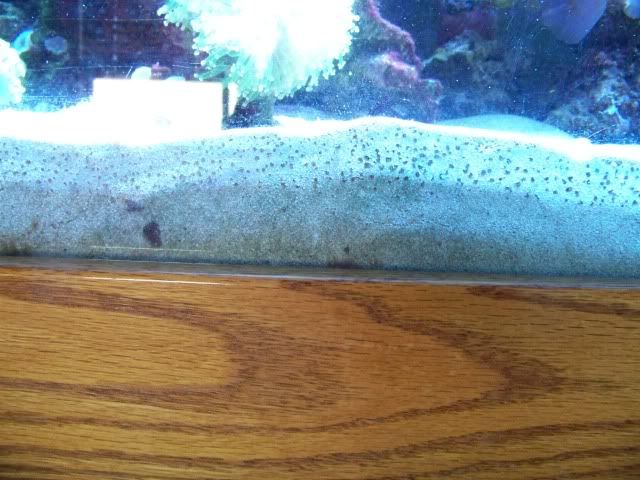 Here is the hydno frag I got from Nick, hasn't really grown since I got it about 4 months ago. It's in about 6" of water.
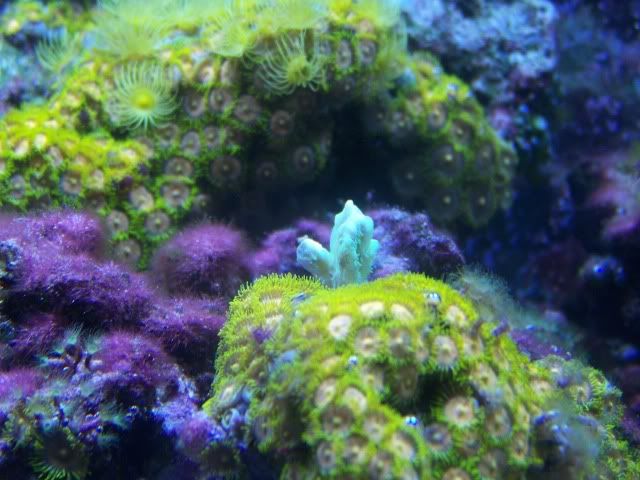 Here are test results. This is the only type of test I have ever used, is there one that is easier/more accurate. I put up 3 pics because it changes so much with viewing angle/light etc.
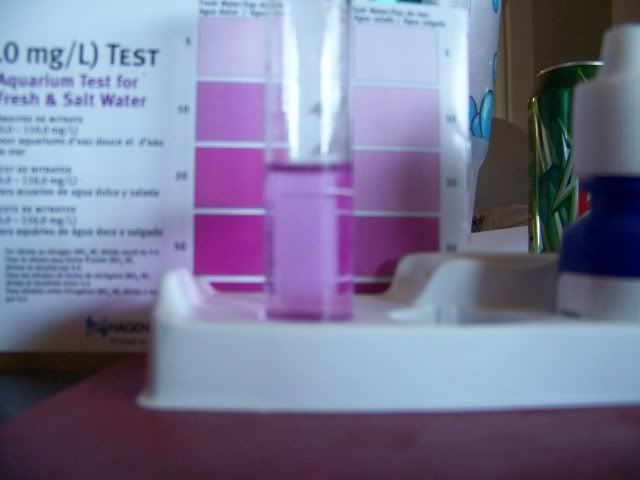 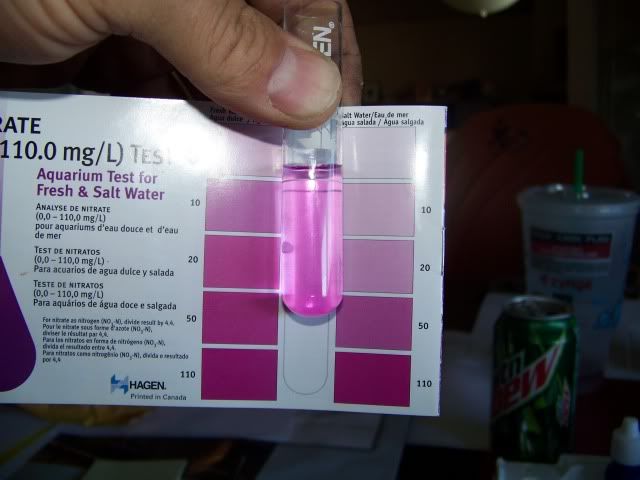 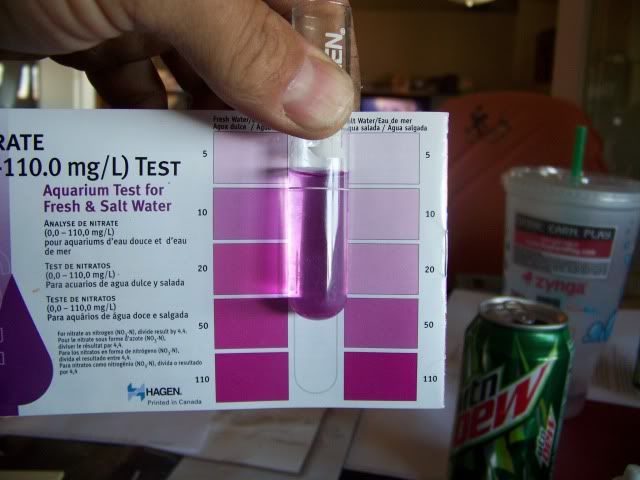 ------------- Some day, when I grow up,... |
Posted By: bugzme
Date Posted: June 27 2010 at 6:46pm
|
Mike I have the siefert test if you want to come over and use it ------------- Jeff 125 tank 50 gallon sump T-5 lighting Rum drinker, Carbon User I KNOW ROCKS THAT ARE YOUNGER THEN ME!! I AM A Realist! I write what I think!! |
Posted By: Mark Peterson
Date Posted: June 28 2010 at 9:37am
|
I agree that M.digitata is typically the easiest fastest growing SPS, yet some tanks don't grow it as well as Acropora. One of the hardiest Acro is the Green Slimer (A. yongei). There should be plenty of that here in the club. You are right. The bubbles can be an indication of denitrificaton. They can also be the result of simple oxygen production via photosynthesis of the algae at the edge of the glass. Yes, the improved look of the coral and anemones is because of cleaner water due to reduced N compounds. As you have seen, the reduction of feeding can allow the biological filtration to quickly eat up the extra nutrients. My guess, just from the pics is that the sand is being disturbed too often. Sounds like you are more concerned about black sand than you need to be. Dirty sand is actually healthy sand enabling good biofiltration. That frag of Hydnophora looks irritated. It should be all bushy. (If you hadn't told us it was Hydno, I would have guessed it was a green Sinularia.) It is sitting in a soup of chemicals produced by the field of green and purple polyps it is living amongst. I would move it to a new place. You are using AC, right? ------------- Reefkeeping Tips, & quick, easy setup tricks: www.utahreefs.com/forum/forum_posts.asp?TID=9244 Pay it forward - become a paid WMAS member 
|
Posted By: Matthew
Date Posted: June 28 2010 at 12:31pm
|
Yes denitrification in sand beds will be the conversion of nitrate to nitrogen gas. I would say though that the bubbles at the top half are not going to be oxygen starved like you would need for denitrification, that should occur deeper in the sand bed.
Edit ps: Oh and I hate test kits that are that non-specific and hard to read. I have bought tons when first buying kits and they bug me every time.
|
Posted By: Mark Peterson
Date Posted: June 28 2010 at 8:26pm
Bubbles that come from the deep and leave a little trail as they rise up the glass are definitely Nitrogen. It's my understanding that the other compound that forms in the process is water; hard to see that one.
------------- Reefkeeping Tips, & quick, easy setup tricks: www.utahreefs.com/forum/forum_posts.asp?TID=9244 Pay it forward - become a paid WMAS member 
|
Posted By: bugzme
Date Posted: June 28 2010 at 8:33pm
|
If your nitrates are under 20 your doing good! Naturally Lower number would be better. Anything above 30 would start hard corals to fade. ------------- Jeff 125 tank 50 gallon sump T-5 lighting Rum drinker, Carbon User I KNOW ROCKS THAT ARE YOUNGER THEN ME!! I AM A Realist! I write what I think!! |
Posted By: fishoutawater
Date Posted: June 28 2010 at 11:37pm
|
I may take you up on your offer to use your test kit Jeff, some days I look at those pics and think 10?, then I look at the other pic and think 50?, irritating.
Wouldn't the bubbles seen in the top of the sand bed just be a lot of smaller bubbles accumulating and getting larger as they travel up from deeper in the sand bed?
Yes, I am using carbon. ------------- Some day, when I grow up,... |
Posted By: fishoutawater
Date Posted: June 30 2010 at 9:41pm
What do you guys think of this?
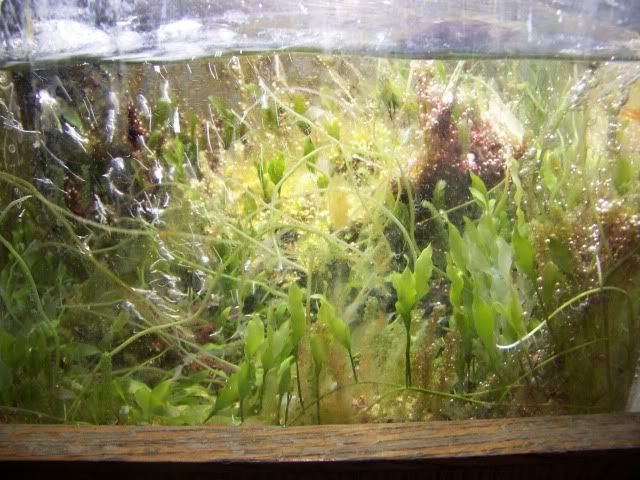 Flow through the fuge is around 250-300 gph. I have a little bit of cyano in the display, but you have to look to find it, nothing like here. In addition to that you can see some of the caulerpa kind of disintegrating, while other areas are a deep healthy green color. I have never ran caulerpa before so this too is new to me. I haven't seen this in any of the tanks I take care of at work, so I'm really not sure what is going on with my macro either. I got it from Nick a few months ago and it did not look like this. ------------- Some day, when I grow up,... |
Posted By: Mark Peterson
Date Posted: July 01 2010 at 7:35am
There that was great. Thanks for posting a pic of the Refugium. Okay I went back and read all that you said about this situation. Here is what is I believe is happening in this system. - There is not enough LS biofiltration. Partly because of the sand in the main display being disturbed too often and partly because there is no sand in the Refugium. - I'm guessing that the algae in the Refugium is not being harvested, probably because it is not growing that well. The yellow, dieing and dissolving algae is putting nutrients back into the Refugium where the remaining algae is absorbing those N compounds just to stay alive. Caulerpa fronds are typically not more than two feet long. In ideal conditions Caulerpa multiplies by branching. - Just for fun, I would test a sample of the water directly from the outlet of the Refugium. My guess is that the Nitrates will show closer to zero there. If not, this blows my whole theory.  - There needs to be more flow through the Refugium. This would make better use of the Refugium by feeding the 50ppm Nitrates to the Caulerpa and the new sand bed. There is no need to build in an RDSB if the present Refugium is put to better use. Of course I could be wrong about this.  ------------- Reefkeeping Tips, & quick, easy setup tricks: www.utahreefs.com/forum/forum_posts.asp?TID=9244 Pay it forward - become a paid WMAS member 
|
Posted By: fishoutawater
Date Posted: July 01 2010 at 10:00am
|
Hmm, every answer leads to more questions.
Why more flow? The consensus seems to be that you should process just a little more water than your skimmer can handle through your sump. A 40 gal display, with 300gph through the returns is just over a 7x turnover, again right about where most of my reading recommends me being.
If caulerpa takes nutrients from the water, and my trates are 20-50, what is it they are not getting that they need? Since parts of it are yellowing/fading, would it be a good idea to prune back a lot of what is in there? Does caulerpa prefer to root in sand? I have increased the light period in the fuge to 16 hours from 12, and will stop blowing the sand in the display.
What benefit could I expect from another sandbed in the fuge, it only measures 10x14, I didn't think that much sand would have much of an impact. ------------- Some day, when I grow up,... |
Posted By: Chris Scott
Date Posted: July 01 2010 at 11:26am
What would you say would be a good schedule to vacuum a dsb? never? I have heard conflicting stories on whether to vacuum a sandbed. If I am trying to have a dsb, should I vacuum just the top and not go too deep, or just let my nassurius snails (and I plan to get a cucumber) move it around a bit? Thanks, Chris ------------- 55g Bowfront Corner Reef |
Posted By: Mark Peterson
Date Posted: July 01 2010 at 12:25pm
|
Okay, so what about my suggestion to check the Nitrate level of the water in the Refugium? I'm assuming you took water from the display for the tests. If I'm right, then more flow through the Refugium will drop the Nitrates in the display. Caulerpa also needs Phosphate and Iron. Have you been using PO4 removal media? You might be surprised what a little extra sandbed will do. I often recommend that a few quarts of Oolitic sand be placed underneath a courser particle sandbed. It reduces N and eliminates Cyano. Conflicting stories? It's very important to take into account the length and amount of experience of any person making recommendations.) Yes, the last line. I only recommend vacuuming the deeper sandbed when nothing at all has been done with it for 4+ years. What I have found best for a sand bed is to periodically stir portions of it by hand or with a stick. A Turkey baster or Syringe with a straw can be used to push water into the sand bed to make a puff of detritus. Coral and other inverts love it, because that is food for them. ` When I worked for a maintenance company, I soon recognized that vacuuming is what guarantees their job. The regular vacuuming of a sandbed removes and disturbs the flora and fauna, the life in the LS. It creates the need for regular vacuuming to remove detritus and clean up the algae that grows on the sand because there is no decent life there. Hope that helps bring up a few more questions.  ------------- Reefkeeping Tips, & quick, easy setup tricks: www.utahreefs.com/forum/forum_posts.asp?TID=9244 Pay it forward - become a paid WMAS member 
|
Posted By: Jake Pehrson
Date Posted: July 01 2010 at 12:48pm
|
First off I would like to admit that I just skimmed through the above posts. Here are a couple of my opinions. *Bubbles in a sand bed do not necessarily translate to denitrification, the best indicator of good nitrification is low nitrates. *I think it is a good thing to vacuum your sand bed at least every once in a while (a few times a year). I usually don't vacuum the entire bed, usually I only do a partial area. I also only vacuum the very top layer. Vacuuming the sand bed too often can be detrimental instead of helpful. * ------------- Jake Pehrson Murray http://coralplanet.com" rel="nofollow - coralplanet.com http://utahbeeranch.com" rel="nofollow - :) |
Posted By: Chris Scott
Date Posted: July 01 2010 at 1:27pm
Thats a good clarification, I should have said I've had conflicting recommendations from different people.  I now get my recommendations right here. Thanks, Chris ------------- 55g Bowfront Corner Reef |
Posted By: fishoutawater
Date Posted: July 01 2010 at 9:57pm
|
I do not use a phosphate remover, but it doesn't register on the test kits. since I have algae growing I assume that I do in fact have some in the water.
Testing from the water exiting the fuge shows no significant change, running over 20x/hr the sump volume through it that doesn't surprise me.
Changes to date over the last 3 months:
Started running a filter sock
Cut feedings in half or even less for the last week
Added 4 hours of light in the fuge, now at 16 hrs.
Stopped basting the sand around the edge of the tank for the last week.
What other suggestions would any of you make? Here is what I am contemplating:
Adding a couple inches of sand to fuge.
24/7 lighting in fuge
Building a coil denitrator
Question not answered in my last post,- should I cut back all of the macro that is decaying along with any that has cyano growing on it?
I know every tank is a little different, If I add sand that will take several weeks/months? to mature and start working, what about the other changes? Would you guys do one at a time and give it a month or so to see what affect it has? Or do it all at once? ------------- Some day, when I grow up,... |
Posted By: Mark Peterson
Date Posted: July 02 2010 at 9:58am
|
Darn, I was hoping for a different number from the Refugium water. Okay that points the resolution in another direction. Let's look at tweaking something that will influence the entire system. Good changes so far. I always run the RDP lights overlapping the main lights by a few hours. 24/7 lighting is not necessary here and because the algae is not growing well anyway, I don't believe it will help at this point. I was being a bit dramatic regarding my no vacuuming comments. I've had too many occasions talking to hobbyists telling me about their really dirty tank and how they vacuumed it often to keep it clean. Of course this only compounds the problem, requiring more and more vacuuming.  Yes, from my experience I would definitely remove the dieing algae. It's just putting unwanted stuff back into the water. I suspect that algae harvesting has not been part of the regimen in this system, right? Because it was not growing. And yet the test shows higher levels of Nitrate. This is the red flag and probably the reason for this thread.  Have you considered using some Chaetomorpha or other Macroalgae along with the Caulerpa? Different Alga can process N at different rates. Have you considered using some Chaetomorpha or other Macroalgae along with the Caulerpa? Different Alga can process N at different rates.If the PO4 test shows nil, that could be a reason for dieing algae and higher N. The lack of Phosphate leaves the algae starved and it cannot grow, thus N stays in the system longer before being processed by the other parts of the biofiltration. The addition of foods containing more PO4 or a chemical form of PO4 could do the job. There are fertilizers meant for Macroalgae. The "f4" fertilizer used to grow phyto could also be used. I've even used Miracle Grow fertilizer. Algae needs iron to grow. Coil denitrators work extremely slow. I wouldn't waste my time on this one. Clean sand will start to populate immediately and it's effect will show as early as one week. Oolitic sand is especially useful since it requires less sand to do the job. If this were my tank, I would do two things first: 1. Add Oolitic sand to the tank, placed under the existing sand. (Make several depressions down to the glass, slowly pour Oolitic into the depression and cover it over with the old sand.) Since most Nitrates are processed in the deepest area of the sandbed (also in the deepest part of LR) this action goes straight to the need, to reduce Nitrates. 2. Add another type of Macroalgae. This will help the Refugium. Caulerpa is so prone to go sexual anyway, that the additional variety of algae not only seems to inhibit the sexual dissolving of Caulerpa but it adds to the N processing ability of the Refugium in general. 3. I would consider a tiny amount of PO4 and Fe rich fertilizer and watch for an immediate spurt in growth. Adding a sandbed to the Refugium is optional at this point and if it were me I would hold off just to see what difference items 1, 2 and 3 make.  ------------- Reefkeeping Tips, & quick, easy setup tricks: www.utahreefs.com/forum/forum_posts.asp?TID=9244 Pay it forward - become a paid WMAS member 
|
 fishoutawater wrote:
fishoutawater wrote: